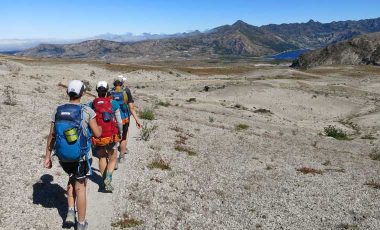It was 5am when I tightened the laces on my trail running shoes, strapped on my lightweight pack, and started up the Pacific Crest Trail. My husband Marty and I ran all day and into the next sunrise. When we arrived at Snoqualmie Pass, exhausted and smiling, we had covered 75-miles of the rugged mountain trail. Our packs were light, but still included safety equipment to deal with unexpected weather or an emergency in the backcountry.
How could I share the trails that reach deep into the lush forests and rugged mountains of the Pacific Northwest with my 13-year-old son who wasn’t a trail runner? When I asked Keenan if he’d be up for a three-day hiking trip if his pack weighed only 16 pounds (instead of the 30+ pounds of a traditional three-day pack), he enthusiastically said yes. The words half the weight, twice the fun ran through my mind as we set off on for our first family fastpack on the trails near Mount St. Helens.
- What is fastpacking?
- Planning your first fastpacking trip
- Gear and food for fastpacking
- Chris Fagan’s fastpacking list and favourite gear
- Mindset
What is fastpacking?
Fastpacking focuses on traveling fast and light through the backcountry, usually for more than one day. It’s similar to ultralight backpacking. The sport has attracted day-hikers, backpackers and trail runners who want to travel light and go further.
Fastpacking delivers benefits to:
- Day-hikers who are ready to try multi-day hikes but don’t want to carry 30-40 pound packs
- Backpackers who want to lighten their load to be more comfortable and cover more ground in less time
- Trail runners who want to venture to more remote locations on multi-day runs that require camping overnight
Whether your focus is on the comfort of carrying less weight, or the freedom to roam farther with minimal equipment, fastpacking can help you be self-sufficient and safe while meeting your goals.
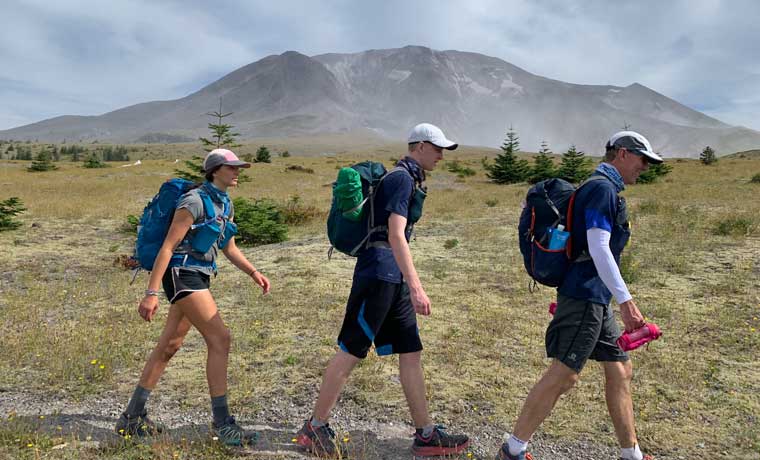
Planning your first fastpacking trip
Consider several factors as you choose a route and plan for your fastpacking adventure:
Experience in the outdoors
Take stock of your outdoor skills and stay well within your experience on your first outing. Know how to read a map, use a compass and navigate. Even if you plan to stick to a well-marked trail, it’s important to have these skills when traveling in the backcountry.
Difficulty of terrain
Consider the elevation gain/loss, trail conditions, water sources and remoteness of a route. How many feet of gain can you comfortably handle in a day? Factor in any physical constraints or ailments that may impact your ability to safely complete the route. Has your knee been acting up lately? If you are a less experienced hiker, backpacker or trail runner, choose a fairly easy route to set yourself up for success.
Number of people in your party
For your first fastpack, include 1-2 other people on your team. You can divvy up the weight of group gear (e.g., tent, stove, first aid kit) and share the adventure with friends. If possible, invite someone experienced in fastpacking to mentor you along the way.
Length of the trip
A fastpack trip of 2 nights/3 days provides enough time to hike or run into the backcountry and test out your fastpack system without the additional weight and commitment required for longer trips.
Time of year
Fastpacking is the most fun in the late spring, summer or early fall. It’s hard to travel fast and light if you are carrying more weight to be safe in winter conditions.
Other considerations
Be sure to check the weather forecast, read trip reports for the area, research permits required for trailhead parking and camping, and brush up on Leave No Trace standards for reducing your impact in the wild.

When we introduced Keenan to fastpacking, we chose the 34-mile Loowit Trail that circumnavigates Mount St. Helens. There are few places in the world where you can hike through the once-ravaged slopes of a volcanic blast zone and experience brilliant wildflowers and a recovering ecosystem. This stark, otherworldly beauty is unmatched and undiscovered (I have rarely seen more than a handful of people on this trail).
Given my son’s physical fitness and backpacking experience, he easily handled hiking 5-6 hours per day, giving us plenty of time to enjoy our time at camp each night. By the end of our trip, there were no complaints of blisters or backaches from a heavy pack.
Since that first fastpacking trip with my son, we’ve returned to Mount St. Helens three more times (we can’t get enough of this unique route). For each outing, friends and their teenage kids joined our family for their first fastpacking experience.
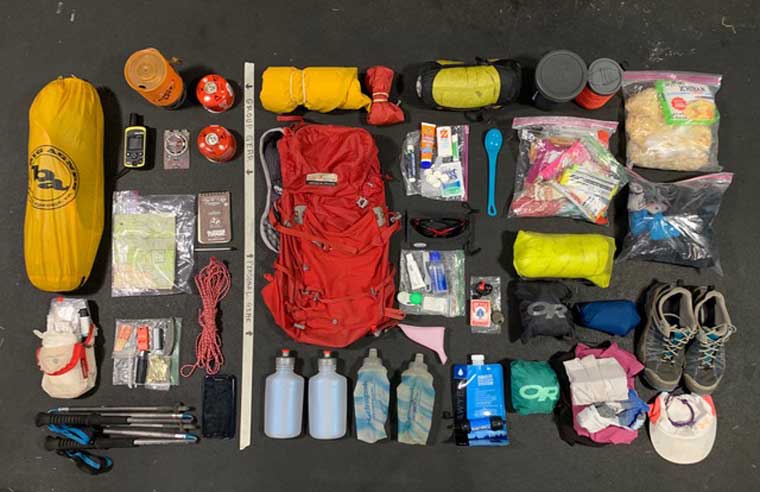
Gear and food for fastpacking
Try my time-tested rules for going light and safe in the backcountry:
Focus on necessities
Ask yourself if an item is a necessity or a luxury. Leave the comfy camp chair and change of shoes at home. Full disclosure: even though my blow-up pillow is non-essential, it only weighs 2 ounces, takes up little space, and makes me smile, so I bring it along.
Invest in light gear for the long haul
If you find you love fastpacking, gradually upgrade to light high-quality gear. If you don’t have the cash to invest, try to rent or borrow items like a lightweight tent, sleeping bag, or a down jacket for your outing.
Find multiple purposes for items
In the summer, I bring my 50-degree down sleeping bag and lightweight down jacket. I sleep in both of them at night if the temperature drops so I don’t have to carry a warmer (heavier) bag. My hiking poles work as tent poles for my tarp. My water filter bag doubles as an extra water bottle.
Bring only one set of clothes
Don’t plan on changing clothes every day. My one exception is an extra pair of socks. Yes, you may be dirty and stinky at the end of your outing. Embrace it.
Cut every ounce
The goal is to have less weight on your back. Cut your toothbrush handle down. Remove unneeded straps.
Bring non-perishable food
Use dehydrated meals for breakfast and dinner. Eat snackable items like bars and jerky throughout the day. Repackage food into lightweight baggies.
My mantra: Bring what you really need, leave what you don’t.
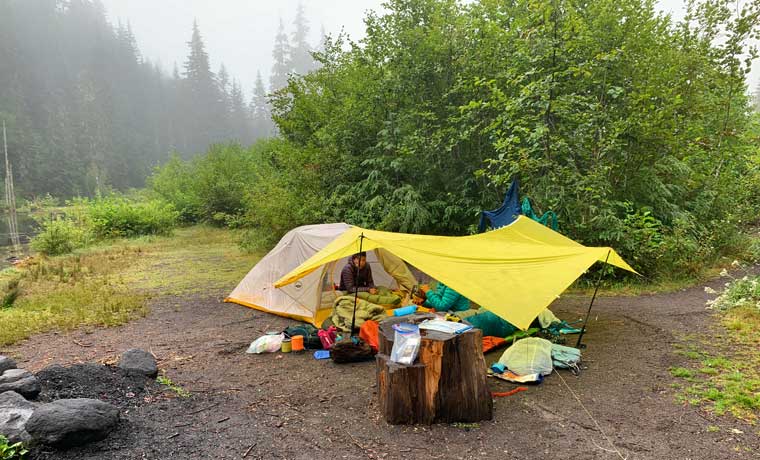
Chris Fagan’s fastpacking list and favourite gear
My pack for a 2 night/3 day trip typically weighs around 16-17 pounds as I set off down the trail (after dividing up group gear like tent and stove with 1-2 teammates). Here’s what I carry:
- Backpack: A 20-30 liter pack that is lightweight and form-fitting (check out trail running fastpacks)
- Clothing: Running shorts, short sleeve shirt, long sleeve shirt, tights, socks, hat, buff, lightweight gloves, windbreaker jacket, rain jacket, rain pants, lightweight down puffy, trail running shoes or lightweight boots
- Shelter: A tent, tarp or bivy
- Sleeping system: Lightweight down sleeping bag, inflatable pad, inflatable pillow
- Navigation: GPS, compass, paper map, digital map on a smartphone
- Kitchen: Stove, fuel, cup, spoon, lighter, waterproof matches
- Food: Dehydrated food, various snacks, cord (to hang food)
- Water: water bottles, water filter
- Safety gear: First aid kit, repair kit, knife
- Sun protection: Baseball hat, sunscreen, lip protection, sunglasses
- Hygiene: Toothbrush, toothpaste, toilet paper or wet wipes, contact solution and contact holder, feminine hygiene products
- Hiking poles
- Headlamp
To facilitate going light, weigh each item on your gear list. I saved four ounces when I upgraded to a lighter down puffy. I dropped a pound when I switched to a lightweight raincoat and rain pants. Lighter items also tend to take up less space in packs.
Download a list of my specific gear here.
Check out the The Mountaineers recommended 10 essentials to carry when traveling into the backcountry.
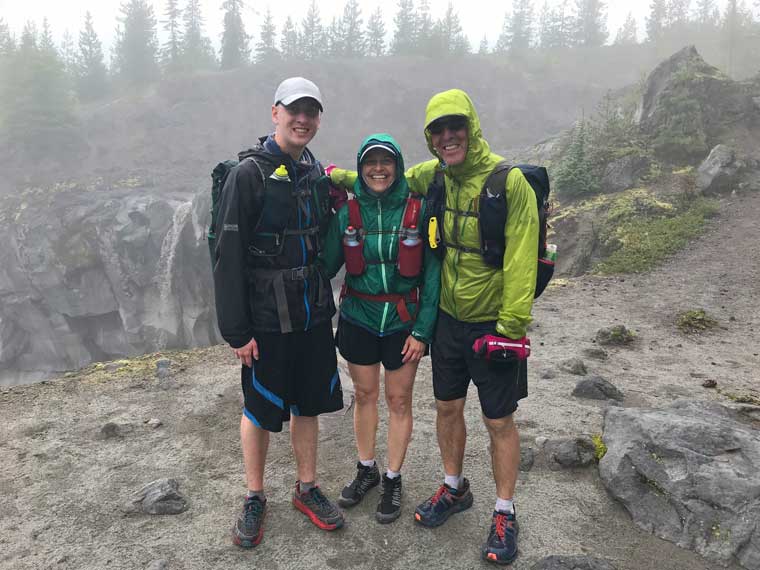
Mindset
For many, fastpacking is about letting go of comforts in favour of a lighter pack. For trail runners, it’s about adding a few critical items to your kit to help you safely reach further into the backcountry.
Ready to set yourself free from a heavy pack? Or challenge yourself to the wild experience of a multi-day trail run?
Say yes to fastpacking. The backcountry is waiting for you.
Learn more about Chris’ adventures at www.chrisfagan.net, check out her book, or follow her on Facebook, Instagram or Twitter.


